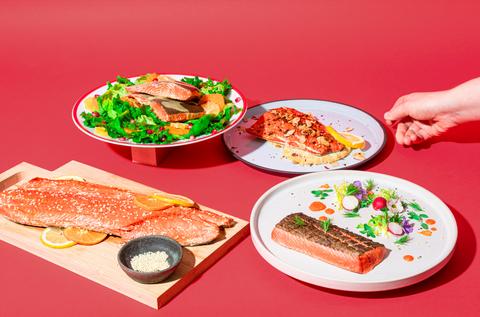Have you ever found yourself staring at a beautiful fillet of salmon, unsure of what to do with it? Fear not, my friend! Cooking salmon at home is easier than you think, and the result can be a tantalizing and flavorful masterpiece. Specifically, let’s talk about Copper River salmon – the crème de la crème of salmon sourced from Cordova, Alaska. This article will guide you through the process of cooking Copper River salmon to perfection, along with some secret tips to elevate its flavor and texture. Trust us, you won’t want to miss this!
Exploring the Culinary Possibilities
When it comes to cooking Copper River salmon, the culinary possibilities are endless! You can bake it, pan fry it, grill it, poach it, use it in sushi, or even make salmon patties. Whatever your culinary preferences, salmon can fit right in. Now, let’s delve into the basics of cooking salmon at home.
Mastering the Art of Seasoning
To create a stellar salmon dish, fresh salmon is key. The seasoning should enhance the natural flavors and richness of the fish itself. Before seasoning, ensure your salmon is completely thawed. Now, let’s talk about different flavor profiles. Whether you prefer smoky, sweet, salty, or spicy, there’s a seasoning that will complement your Copper River salmon perfectly. For a fresh and summery taste, try citrus and herb seasonings like lemon, lime, mint, chives, or dill. Feeling health-conscious? Lightly season your salmon fillet and pair it with a refreshing salad. If you want to indulge in sweetness, experiment with maple syrup, honey, or brown sugar. Combining sweetness with savory is a delightful choice for Copper River salmon, known for its buttery texture due to its high Omega-3 content. A dose of soy sauce, miso, or capers can also enhance the flavors. And, if you prefer to let the natural flavors shine, a sprinkle of salt and pepper with a quick sear will do the trick.
The Pan-Frying Technique
If you prefer a stovetop cooking method, pan frying is an easy and quick option that anyone can master. Start by seasoning your Copper River salmon and placing it in a hot, non-stick pan with a bit of oil. Fry the salmon for 3 minutes on one side, then flip it and cook for another 4 to 6 minutes, depending on your desired level of doneness. Remember, practice makes perfect, so don’t be discouraged if your first attempt isn’t flawless.
Baking Salmon for Effortless Cooking
If flipping fish in a pan isn’t your idea of fun, baking Copper River salmon might be the solution for you. It’s a simple cooking method that requires minimal effort. Start by preheating your oven to 450 degrees. Season your salmon to taste and place it skin-side down on a greased or non-stick baking sheet. Pop it in the oven for up to 15 minutes – that’s it! Baking ensures even cooking and allows you to tend to other tasks while your salmon cooks to perfection.
Grilling for Unparalleled Flavor
Grilled salmon is a truly unbeatable culinary delight, particularly when it’s Copper River salmon. Although it requires a bit more effort than other methods, the end result is well worth it. Begin by allowing your salmon to come to room temperature and patting it dry. Clean your grill and coat it with olive oil. Heat your grill to create two areas of heat – a hotter one for searing and a cooler one for finishing. Season your salmon as desired, then sear it skin-side down on the hot area of the grill for about 8 minutes. Flip the fish and move it to the cooler area to finish cooking for approximately 4 minutes. Voila! You have a perfectly grilled Copper River salmon ready to tantalize your taste buds.
Elevate Your Cooking with Salmon Patties
Once you’ve mastered baking Copper River salmon, taking it a step further by making salmon patties is a fantastic culinary adventure. Start by flaking the cooled baked salmon into a mixing bowl, then combine it with other ingredients typically used in crab cakes. Shape the mixture into patties and cook them on a stovetop or in the oven. These patties can be a versatile addition to your meal repertoire.
The Art of Knowing When it’s Done
Cooking salmon to perfection is a matter of personal preference, but there are general guidelines to follow. The FDA recommends cooking salmon until it reaches an internal temperature of 145 degrees. However, if you prefer a juicier and more delicate texture, aim for an internal temperature of 120 degrees. Don’t have a thermometer? No worries! Simply press a fork against the fillet to check its tenderness. If it starts to flake apart, it’s done cooking. Keep in mind that removing the salmon from heat while slightly undercooked prevents it from becoming tough or chewy. The resting time after cooking will ensure it reaches perfection.
Prep Like a Pro: The Insider Secret
Preparing your Copper River salmon properly is often overlooked but can make a world of difference. Mastering this step will elevate your dish to a whole new level. Begin by thawing your salmon completely, then generously cover it with salt. Let it rest for 5 minutes before rinsing it thoroughly in the sink. Gently pat the salmon dry on a cutting board. By following these simple steps, you’ll enhance the texture and pure flavor of your salmon, making it appear as if you’ve been a culinary expert for years.
Now that you’re armed with the secrets of cooking Copper River salmon, it’s time to embark on this delightful culinary journey. Try out various cooking methods and seasonings, and don’t forget to share your incredible creations with us on social media. If you’re ready to start your cooking adventure, head over to Ekilove to order your wild Copper River salmon today!




